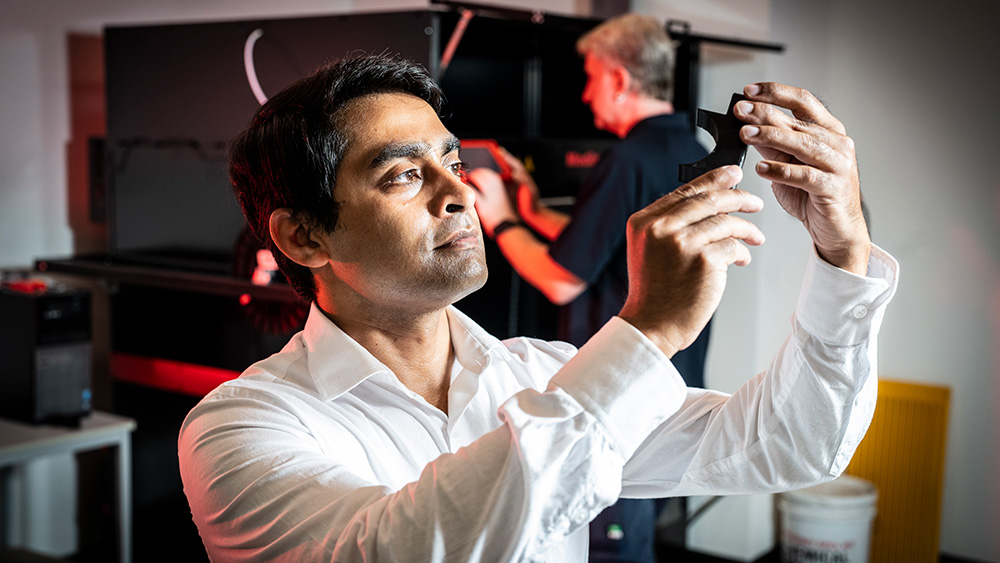Turning plastic waste into homewares
International team to create community-based plastic recycling system
August 1, 2024
In Australia, just 12 per cent of recyclable plastic produced each year is being recycled, and 88 per cent of all possible recyclable plastics ends up in landfill.
Dr Aziz Ahmed, a lecturer in Structural Engineering in the School of Civil, Mining, Environmental and Architectural Engineering at the University of Wollongong (UOW) is working with an international cross-disciplinary team to revolutionise and localise plastics recycling.
The project, funded by the National Science Foundation’s Convergence Accelerator Program in the United States, and CSIRO in Australia, aims to deploy a net-zero manufacturing system that empowers everyday people, even with limited expertise, to design and 3D print homewares from plastic waste. The initiative promotes sustainable infrastructure and generates significant socio-economic benefits.
UOW project lead Dr Ahmed is working in a team led by Texas-based social enterprise re:3D and researchers from Austin Habitat for Humanity, The University of Texas at Austin, Georgia Institute of Technology and Western Sydney University.
Recycling plastics is fraught with challenges related to collection, sorting, contamination, and economic viability. Additionally, the cost of recycling is often higher than producing new plastics due to low oil prices and advanced production techniques, making recycling economically unfeasible in many cases. The recycling process itself can be resource-intensive, diminishing some of its environmental benefits.
Dr Ahmed said there can be a negative feedback loop on household recycling.
“People can be discouraged from recycling because of a perception that the collected materials may end up not actually being recycled. The approach we’re exploring in this project is trying to bring the power to the people and create an innovative way to recycle plastics within the community,” Dr Ahmed said.
Having gathered community ideas and perspectives in the first stage of the project, the team will now begin a pilot program at the Austin Habitat for Humanity ReStore in Texas upskilling workers in the new manufacturing system and diverting 4.5 metric tonnes of plastic waste into homewares within two years.
“Our aim is to build a full-scale prototype of a shipping container-based 3D printing enabled recycling facility in a community in the first year and to monitor and measure various aspects over the next two years.”
“Unlike regular 3D printers that use specialised filaments that you need to buy, our project will use Gigabot X and X2 printers that can print directly from granules that have been shredded on site from recyclable containers like soft drink bottles.
“For example, ReStore staff will take plastic donations that they cannot sell and shred those plastics into granules and print something useful from a wide range of unique customisable designs. Some experiments have seen us print a chair, or a flower vase along with a wide range of innovative designs,” Dr Ahmed said.
Customers will use an interactive web-based design platform which is powered by experiments and artificial intelligence-based design optimisation technology.
 Dr Ahmed hopes to reverse negative perceptions of recycling through the innovative 3D printing project.
Dr Ahmed hopes to reverse negative perceptions of recycling through the innovative 3D printing project.
This pilot phase of the project will also be used to measure inputs and outputs with the goal of fine-tuning the net-zero recycling and printing facilities.
“We are going to monitor almost everything around the unit. We will continuously report on how much plastic has been recycled, how much carbon dioxide has been produced, monitor the air quality and the used water for microplastics.”
The 3D printers can essentially print anything, but in this pilot the team will be exploring the use for homewares and furniture.
“It could be small or large - anything that fits in one metre cube volume can be printed at one go. Modular designs can be used to make even larger objects combining smaller parts.
“We also think the facility can help with repair and reuse culture. Sometimes a small part breaks and renders the whole item unusable. With this system, if you can make a 3D drawing of the broken part you can print that part and make the whole thing usable again.
“The ultimate goal of this project is to create a recycling system that will be sustainable and beneficial for the community in the long run. Within one year or so, the prototype will be ready, and we will be able to experience how a community adopts it.
“At the end of phase two, we are going to have enough information around this prototype that we can reproduce a version of it anywhere in the world. Any community will be able to recycle their own plastics into usable household items on-site using the knowledge obtained in phase two” Dr Ahmed said.
UOW is committed to addressing the United Nations Sustainable Development Goals, which provide a shared blueprint to achieve a better and more sustainable future for everyone. This project addresses Sustainable Development Goal 11 which aims to move toward sustainable cities and communities and Goal 12, ensuring sustainable consumption and production.